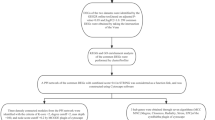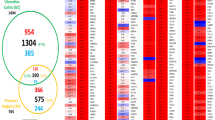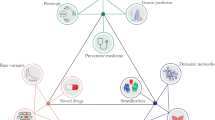Abstract
Despite the abundance of epidemiological evidence for the high comorbid rate between psoriasis and obesity, systematic approaches to common inflammatory mechanisms have not been adequately explored. We performed a meta-analysis of publicly available RNA-sequencing datasets to unveil putative mechanisms that are postulated to exacerbate both diseases, utilizing both late-stage, disease-specific meta-analyses and consensus gene co-expression network (cWGCNA). Single-gene meta-analyses reported several common inflammatory mechanisms fostered by the perturbed expression profile of inflammatory cells. Assessment of gene overlaps between both diseases revealed significant overlaps between up- (n = 170, P value = 6.07 × 10−65) and down-regulated (n = 49, P value = 7.1 × 10−7) genes, associated with increased T cell response and activated transcription factors. Our cWGCNA approach disentangled 48 consensus modules, associated with either the differentiation of leukocytes or metabolic pathways with similar correlation signals in both diseases. Notably, all our analyses confirmed the association of the perturbed T helper (Th)17 differentiation pathway in both diseases. Our novel findings through whole transcriptomic analyses characterize the inflammatory commonalities between psoriasis and obesity implying the assessment of several expression profiles that could serve as putative comorbid disease progression biomarkers and therapeutic interventions.
This is a preview of subscription content, access via your institution
Access options
Subscribe to this journal
Receive 6 digital issues and online access to articles
$119.00 per year
only $19.83 per issue
Buy this article
- Purchase on Springer Link
- Instant access to full article PDF
Prices may be subject to local taxes which are calculated during checkout



Similar content being viewed by others
Data availability
All datasets included in our study are available from the Gene Expression Omnibus database repository (https://www.ncbi.nlm.nih.gov/geo/, accessed on 3 September 2022).
Code availability
Softwares used in this study are available at: SRA tookit, https://github.com/ncbi/sra-tools; FastQC, https://github.com/s-andrews/FastQC; TrimGalore, https://github.com/FelixKrueger/TrimGalore; STAR, https://github.com/alexdobin/STAR; RSeQC, https://github.com/MonashBioinformaticsPlatform/RSeQC; Subread, https://github.com/ShiLab-Bioinformatics/subread; DESeq2, https://github.com/thelovelab/DESeq2; MetaVolcanoR, https://github.com/csbl-usp/MetaVolcanoR; clusterProfiler, https://github.com/YuLab-SMU/clusterProfiler; WGCNA, https://horvath.genetics.ucla.edu/html/CoexpressionNetwork/Rpackages/WGCNA/; Cytoscape, https://cytoscape.org/. Code used in the manuscript is available at: https://github.com/antonatosc/psobesity.
References
Parisi R, Symmons DPM, Griffiths CEM, Ashcroft DM. Global epidemiology of psoriasis: a systematic review of incidence and prevalence. J Investig Dermatol. 2013 Feb;133:377–85.
Tsoi LC, Stuart PE, Tian C, Gudjonsson JE, Das S, Zawistowski M, et al. Large scale meta-analysis characterizes genetic architecture for common psoriasis associated variants. Nat Commun. 2017;8:15382.
Bu J, Ding R, Zhou L, Chen X, Shen E. Epidemiology of psoriasis and comorbid diseases: a narrative review. Front Immunol. 2022;13:880201.
Chen L, Li J, Zhu W, Kuang Y, Liu T, Zhang W, et al. Skin and gut microbiome in psoriasis: gaining insight into the pathophysiology of it and finding novel therapeutic strategies. Front Microbiol. 2020;11:589726.
Hedin CRH, Sonkoly E, Eberhardson M, Ståhle M. Inflammatory bowel disease and psoriasis: modernizing the multidisciplinary approach. J Intern Med. 2021;290:257–78.
Ellulu MS, Patimah I, Khaza’ai H, Rahmat A, Abed Y. Obesity and inflammation: the linking mechanism and the complications. aoms. 2017;4:851–63.
Longo M, Zatterale F, Naderi J, Parrillo L, Formisano P, Raciti GA, et al. Adipose tissue dysfunction as determinant of obesity-associated metabolic complications. IJMS. 2019;20:2358.
Snekvik I, Smith CH, Nilsen TIL, Langan SM, Modalsli EH, Romundstad PR, et al. Obesity, waist circumference, weight change, and risk of incident psoriasis: prospective data from the HUNT study. J Investig Dermatol. 2017;137:2484–90.
Barros G, Duran P, Vera I, Bermúdez V. Exploring the links between obesity and psoriasis: a comprehensive review. IJMS. 2022;23:7499.
Leinonen R, Sugawara H, Shumway M, on behalf of the International Nucleotide Sequence Database Collaboration. The sequence read archive. Nucleic Acids Res. 2011;39:D19–D21.
Dobin A, Davis CA, Schlesinger F, Drenkow J, Zaleski C, Jha S, et al. STAR: ultrafast universal RNA-seq aligner. Bioinformatics. 2013;29:15–21.
Cunningham F, Allen JE, Allen J, Alvarez-Jarreta J, Amode MR, Armean IM, et al. Ensembl 2022. Nucleic Acids Res. 2022;50:D988–D995.
Wang L, Wang S, Li W. RSeQC: quality control of RNA-seq experiments. Bioinformatics. 2012;28:2184–5.
Liao Y, Smyth GK, Shi W. featureCounts: an efficient general purpose program for assigning sequence reads to genomic features. Bioinformatics. 2014;30:923–30.
Love MI, Huber W, Anders S. Moderated estimation of fold change and dispersion for RNA-seq data with DESeq2. Genome Biol. 2014;15:550.
Yoon S, Baik B, Park T, Nam D. Powerful p-value combination methods to detect incomplete association. Sci Rep. 2021;11:6980.
Kanehisa M, Sato Y, Kawashima M, Furumichi M, Tanabe M. KEGG as a reference resource for gene and protein annotation. Nucleic Acids Res. 2016;44:D457–62.
Wu T, Hu E, Xu S, Chen M, Guo P, Dai Z, et al. clusterProfiler 4.0: a universal enrichment tool for interpreting omics data. Innovation. 2021;2:100141.
Langfelder P, Horvath S. WGCNA: an R package for weighted correlation network analysis. BMC Bioinform. 2008;9:559.
Zhang Y, Parmigiani G, Johnson WE. ComBat-seq: batch effect adjustment for RNA-seq count data. NAR Genom Bioinform. 2020;2:lqaa078.
Shannon P, Markiel A, Ozier O, Baliga NS, Wang JT, Ramage D, et al. Cytoscape: a software environment for integrated models of biomolecular interaction networks. Genome Res. 2003;13:2498–504.
Bader GD, Hogue CW. An automated method for finding molecular complexes in large protein interaction networks. BMC Bioinformatics. 2003;4:1–27.
Li B, Tsoi LC, Swindell WR, Gudjonsson JE, Tejasvi T, Johnston A, et al. Transcriptome analysis of psoriasis in a large case–control sample: RNA-Seq provides insights into disease mechanisms. J Investig Dermatol. 2014;134:1828–38.
Swindell WR, Remmer HA, Sarkar MK, Xing X, Barnes DH, Wolterink L, et al. Proteogenomic analysis of psoriasis reveals discordant and concordant changes in mRNA and protein abundance. Genome Med. 2015;7:86.
Manczinger M, Kemény L. Novel factors in the pathogenesis of psoriasis and potential drug candidates are found with systems biology approach. PLoS ONE. 2013;8:e80751.
Davidovici BB, Sattar N, Jörg PC, Puig L, Emery P, Barker JN, et al. Psoriasis and systemic inflammatory diseases: potential mechanistic links between skin disease and co-morbid conditions. J Investig Dermatol. 2010;130:1785–96.
Langfelder P, Mischel PS, Horvath S. When is hub gene selection better than standard meta-analysis? PLoS ONE. 2013;8:e61505.
Tian S, Krueger JG, Li K, Jabbari A, Brodmerkel C, Lowes MA, et al. Meta-analysis derived (MAD) transcriptome of psoriasis defines the “core” pathogenesis of disease. PLoS ONE. 2012;7:e44274.
Auguet T, Guiu-Jurado E, Berlanga A, Terra X, Martinez S, Porras JA, et al. Downregulation of lipogenesis and fatty acid oxidation in the subcutaneous adipose tissue of morbidly obese women: altered lipogenic pathway in adipose tissue. Obesity. 2014;22:2032–8.
Caputo T, Tran VDT, Bararpour N, Winkler C, Aguileta G, Trang KB, et al. Anti-adipogenic signals at the onset of obesity-related inflammation in white adipose tissue. Cell Mol Life Sci. 2021;78:227–47.
Gil A, María Aguilera C, Gil-Campos M, Cañete R. Altered signalling and gene expression associated with the immune system and the inflammatory response in obesity. Br J Nutr. 2007;98:S121–6.
Zeng J, Zhang Y, Zhang H, Zhang Y, Gao L, Tong X, et al. RPL22 overexpression promotes psoriasis-like lesion by inducing keratinocytes abnormal biological behavior. Front Immunol. 2021;12:699900.
Gaye A, Doumatey AP, Davis SK, Rotimi CN, Gibbons GH. Whole-genome transcriptomic insights into protective molecular mechanisms in metabolically healthy obese African Americans. npj Genom Med. 2018;3:4.
van der Kolk BW, Saari S, Lovric A, Arif M, Alvarez M, Ko A, et al. Molecular pathways behind acquired obesity: adipose tissue and skeletal muscle multiomics in monozygotic twin pairs discordant for BMI. Cell Rep. Med. 2021;2:100226.
van Vliet S, Koh HCE, Patterson BW, Yoshino M, LaForest R, Gropler RJ, et al. Obesity is associated with increased basal and postprandial β-cell insulin secretion even in the absence of insulin resistance. Diabetes. 2020;69:2112–9.
Succurro E, Marini MA, Frontoni S, Hribal ML, Andreozzi F, Lauro R, et al. Insulin secretion in metabolically obese, but normal weight, and in metabolically healthy but obese individuals. Obesity. 2008;16:1881–6.
Blüher M. Metabolically healthy obesity. Endocr Rev. 2020;41:bnaa004.
Avila Cobos F, Alquicira-Hernandez J, Powell JE, Mestdagh P, De Preter K. Benchmarking of cell type deconvolution pipelines for transcriptomics data. Nat Commun. 2020;11:5650.
Pirro F, Caldarola G, Chiricozzi A, Burlando M, Mariani M, Parodi A, et al. Impact of body mass index on the efficacy of biological therapies in patients with psoriasis: a real-world study. Clin Drug Investig. 2021;41:917–25.
Matarese G. The link between obesity and autoimmunity. Science. 2023;379:1298–300.
Winer S, Paltser G, Chan Y, Tsui H, Engleman E, Winer D, et al. Obesity predisposes to Th17 bias. Eur J Immunol. 2009;39:2629–35.
Park SH, Lee KA, Choi JH, Park S, Kim DW, Jung SY. Impact of obesity on the IL-6 immune marker and Th17 immune cells in C57BL/6 mice models with imiquimod-induced psoriasis. IJMS. 2023;24:5592.
Paroutoglou K, Papadavid E, Christodoulatos GS, Dalamaga M. Deciphering the association between psoriasis and obesity: current evidence and treatment considerations. Curr Obes Rep. 2020;9:165–78.
Maezawa Y, Endo Y, Kono S, Ohno T, Nakamura Y, Teramoto N, et al. Weight loss improves inflammation by T helper 17 cells in an obese patient with psoriasis at high risk for cardiovascular events. J Diabetes Investig. 2023;14:1136–9.
Mrowietz U, Sümbül M, Gerdes S. Depression, a major comorbidity of psoriatic disease, is caused by metabolic inflammation. Acad Dermatol Venereol. 2023;37:1731–8.
Sivasami P, Elkins C, Diaz-Saldana PP, Goss K, Peng A, Hamersky M, et al. Obesity-induced dysregulation of skin-resident PPARγ+ Treg cells promotes IL-17A-mediated psoriatic inflammation. Immunity. 2023;56:1844–1861.e6.
Carrascosa JM, Rocamora V, Fernandez-Torres RM, Jimenez-Puya R, Moreno JC, Coll-Puigserver N, et al. Obesity and psoriasis: inflammatory nature of obesity, relationship between psoriasis and obesity, and therapeutic implications. Actas Dermo-Sifiliográficas. 2014;105:31–44.
Xu C, Ji J, Su T, Wang HW, Su ZL. The association of psoriasis and obesity: focusing on IL-17A-related immunological mechanisms. Int J Dermatol Venereol. 2021;4:116–21.
Lazarevic V, Chen X, Shim JH, Hwang ES, Jang E, Bolm AN, et al. T-bet represses TH17 differentiation by preventing Runx1-mediated activation of the gene encoding RORγt. Nat Immunol. 2011;12:96–104.
Santarlasci V, Maggi L, Capone M, Querci V, Beltrame L, Cavalieri D, et al. Rarity of human T Helper 17 cells is due to retinoic acid orphan receptor-dependent mechanisms that limit their expansion. Immunity. 2012;36:201–14.
Deng J, Leijten E, Nordkamp MO, Zheng G, Pouw J, Tao W, et al. Multi‐omics integration reveals a core network involved in host defence and hyperkeratinization in psoriasis. Clin Transl Med [Internet]. 2022 [cited 23 April 2023];12. Available from: https://onlinelibrary.wiley.com/doi/10.1002/ctm2.976.
Kisielnicka A, Szczerkowska-Dobosz A, Nowicki R. The influence of body weight of patients with chronic plaque psoriasis on biological treatment response. Postepy Dermatol Alergol. 2020;37:168–73.
Wu MY, Yu CL, Yang SJ, Chi CC. Change in body weight and body mass index in psoriasis patients receiving biologics: a systematic review and network meta-analysis. J Am Acad Dermatol. 2020;82:101–9.
Sánchez-Valle J, Tejero H, Fernández JM, Juan D, Urda-García B, Capella-Gutiérrez S, et al. Interpreting molecular similarity between patients as a determinant of disease comorbidity relationships. Nat Commun. 2020;11:2854.
Kisielnicka A, Sobalska-Kwapis M, Purzycka-Bohdan D, Nedoszytko B, Zabłotna M, Seweryn M, et al. The analysis of a Genome-Wide Association Study (GWAS) of overweight and obesity in psoriasis. IJMS. 2022;23:7396.
Antonatos C, Grafanaki K, Georgiou S, Evangelou E, Vasilopoulos Y. Disentangling the complexity of psoriasis in the post-genome-wide association era. Genes Immun. 2023;24:236–47.
Xue X, Wu J, Li J, Xu J, Dai H, Tao C, et al. Indirubin attenuates mouse psoriasis-like skin lesion in a CD274-dependent manner: an achievement of RNA sequencing. Biosci Rep. 2018;38:BSR20180958.
Gupta R, Ahn R, Lai K, Mullins E, Debbaneh M, Dimon M, et al. Landscape of long noncoding RNAs in psoriatic and healthy skin. J Investig Dermatol. 2016;136:603–9.
Keermann M, Kõks S, Reimann E, Prans E, Abram K, Kingo K. Transcriptional landscape of psoriasis identifies the involvement of IL36 and IL36RN. BMC Genom. 2015;16:322.
Tsoi LC, Rodriguez E, Degenhardt F, Baurecht H, Wehkamp U, Volks N, et al. Atopic dermatitis Is an IL-13-dominant disease with greater molecular heterogeneity compared to psoriasis. J Investig Dermatol. 2019;139:1480–9.
Fuchs A, Samovski D, Smith GI, Cifarelli V, Farabi SS, Yoshino J, et al. Associations among adipose tissue immunology, inflammation, exosomes and insulin sensitivity in people with obesity and nonalcoholic fatty liver disease. Gastroenterology. 2021;161:968–981.e12.
Fisk HL, Childs CE, Miles EA, Ayres R, Noakes PS, Paras-Chavez C, et al. Dysregulation of endocannabinoid concentrations in human subcutaneous adipose tissue in obesity and modulation by omega-3 polyunsaturated fatty acids. Clin Sci. 2021;135:185–200.
Gao H, Kerr A, Jiao H, Hon C-C, Rydén M, Dahlman I, et al. Long non-coding RNAs associated with metabolic traits in human white adipose tissue. EBioMedicine. 2018;30:248–60.
Cifarelli V, Beeman SC, Smith GI, Yoshino J, Morozov D, Beals JW, et al. Decreased adipose tissue oxygenation associates with insulin resistance in individuals with obesity. J Clin Investig. 2020;130:6688–99.
Rey F, Messa L, Pandini C, Launi R, Barzaghini B, Micheletto G, et al. Transcriptome analysis of subcutaneous adipose tissue from severely obese patients highlights deregulation profiles in coding and non-coding oncogenes. IJMS. 2021;22:1989.
Acknowledgements
CA was financially supported by the «Andreas Mentzelopoulos Foundation».
Author information
Authors and Affiliations
Contributions
Conceptualization, CA and YV; methodology, CA, GKG, EE and YV; software, formal analysis, CA; data curation, CA; writing—original draft preparation, CA; writing—review and editing, CA, GKG, EE and YV; visualization, CA; supervision, YV. All authors have read and agreed to the published version of the manuscript.
Corresponding author
Ethics declarations
Competing interests
The authors declare no competing interests.
Additional information
Publisher’s note Springer Nature remains neutral with regard to jurisdictional claims in published maps and institutional affiliations.
Rights and permissions
Springer Nature or its licensor (e.g. a society or other partner) holds exclusive rights to this article under a publishing agreement with the author(s) or other rightsholder(s); author self-archiving of the accepted manuscript version of this article is solely governed by the terms of such publishing agreement and applicable law.
About this article
Cite this article
Antonatos, C., Georgakilas, G.K., Evangelou, E. et al. Transcriptomic meta-analysis characterizes molecular commonalities between psoriasis and obesity. Genes Immun (2024). https://doi.org/10.1038/s41435-024-00271-w
Received:
Revised:
Accepted:
Published:
DOI: https://doi.org/10.1038/s41435-024-00271-w



